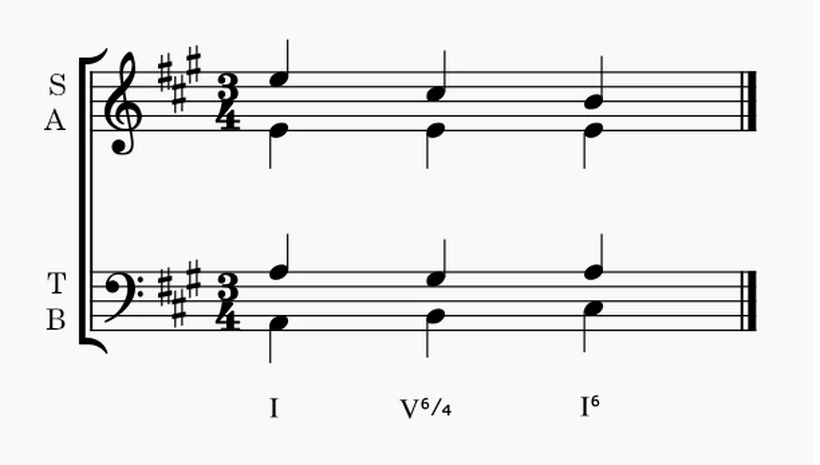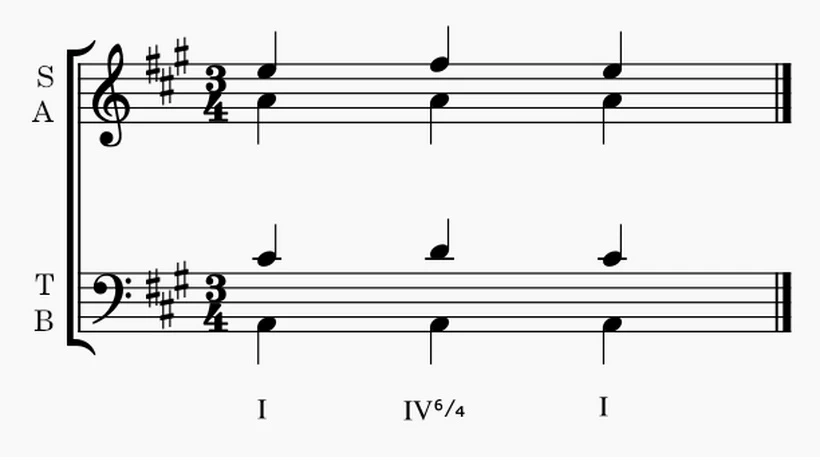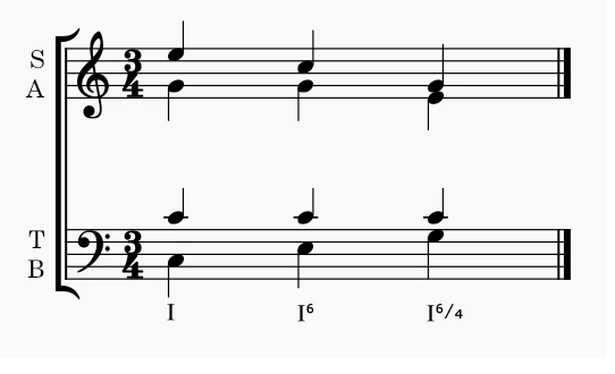Do you want to learn the details of the Second Inversion Triads?
The second inversion triads are formed by moving the root and the third of any triad an octave higher. Like the first inversion triads, they allow you to go in for a melodic bassline, add diversity to your music, etc.
In this article, we will elaborate on their utilities, part writing rules, voice leading, their use as passing chords, neighboring chords, Cadential ⁶⁄₄ Chords, arpeggiated ⁶⁄₄ chords, etc.
Read the complete article to know all this and more.!
Triads In The Second Inversion
A triad in the second inversion is also known as the “6 4 chord” or the “6/4 Chord.” It is formed by raising the root and the 3rd of the original root position triad by an octave. Hence, a fifth of the chord becomes the bass note in the 2nd inversion.
The 2nd and 3rd notes of the 2nd inversion triad have an interval of 4th and 6th with the new bass notes. Hence these chords are commonly known as the “6 4 chords.“
In the major scale, the second inversion of the tonic chord has a chord formula [5 1 3]. For example,
The C major chord [C E G] results in C Major second inversion [G C E].
The G Major second inversion is [D G B].
The F major 2nd inversion is [C F A].
How to Represent A Second Inversion Chord?
The second inversion, like the first inversion, is either notated by the slash chords or through the figured bass system. In slash chord form, the second inversions of the C major and E flat major triad are denoted as C/G and Eb/Bb, respectively.
In the figured bass system with the Roman numerals, the second inversions of C and Eb in the key of C and F, respectively, are denoted as I⁶⁄₄ and IV⁶⁄₄.
Why Use the Second Inversion Chords?
The main reasons for using the second inversion chords in music are the same as those for the first inversions. To have a melody in the bass line, which is a prominent voice, to add variety, a better voice leading, parallel sixths, and expanding the cadence by a few chords as embellishments.
Voice Leading Rules of A Second Inversion Triad
The rules related to the voice leading of the 6 4 chords are more strict than the other voicings. In the first inversion triad, you had the freedom to double any note except the leading tone. In the second inversion, you can only double the bass note of the inverted chord, which is the same as the fifth note of the original chord.
Passing Six Four Chords
A passing ⁶⁄₄ chord must have a stepwise motion, also known as the scale movement, in one direction (up or down) in the bass voice. As you may know, the passing tone is defined by its step-wise approach and resolution. Consider the example of I – V⁶⁄₄ – I⁶. The second inversion of the dominant chord V⁶⁄₄ acts as the passing chord between the I and I⁶ chords, providing variety.
You cannot make any leaps from the I to the V⁶⁄₄ chord in any of the voices and must voice lead by common tones or steps. The same is true for the movement from the V⁶⁄₄ to I⁶, the first inversion triads. See the diagram below.

You can observe that both Soprano and Bass voices move in steps in the contrary motion to each other. The Alto has only common tones and is static, while the Tenor steps down and then returns back to the original note. Instead of the Soprano, you can make the Alto or Tenor step down in a contrary motion to the Bass.
You can also see the voice exchange in action here.
You can also use the same passing chord in the reverse direction in the form of I⁶ – V⁶⁄₄ – I.
Neighbor Six-Four or the Pedal Six-Four Chords.
You can now see the use of the Neighboring Six Four chords, also known as the pedal 6 4 chords. The progression I – IV⁶⁄₄ – I to illustrate their use along with the voices is shown on the diagram below.

The example is in the key of A major. Note that the A note in the bass line and Alto is static. This does not result in a parallel problem, as the notes are static. The notes E and C# in the Tenor and Soprano voices step up to F# and D and step back precisely as a neighboring tone moves, as per the music theory.
As the I chord is a root position chord in the progression, we need to double the root, i.e., A, in both places. A is the 5th in the IV⁶⁄₄ chord, D major, with notes [D F# A]. Hence it is also doubled in the IV⁶⁄₄ chord.
The neighboring chords and the passing chords are usually on metrically weak beats. Notice in both the above examples that these chords occur on beat 2 of the measure 3/4, which is a weak beat. In 3/4, only beat 1 is the strong beat.
Cadential Six Four Chords
The second inversion triads are most commonly found in a cadential six-four chord, where they are placed before the dominant triad in the V – I cadence. They have to be on a metrically stronger beat in the cadential 6 4 application and are said to exhibit a dominant function with the V chord.
Notice that the chord I⁶⁄₄ occurs on beat 3 of the 4/4 time signature, which is a strong beat. Beat 1 and 3 on the 4/4 signature are strong beats.
Consider the example of the progression ii6 – I⁶⁄₄ – V – I showed in the diagram below. This is the classical progression with the Predominant – Dominant – Tonic chords, where the dominant function is carried out by the two chords, I⁶⁄₄ and V.

The cadential 6/4 progression shown is in the key of A major. Note that I⁶⁄₄ has the double bass note or the 5th of the original chord.
Arpeggiated Six-Four Chords
As you know, if instead of playing all the notes of the chord together, you play them one note at a time in a melodic succession, you are playing an arpeggio.
If you play the same chord in the root position, the first inversion and second inversion in succession, I – I6 – I6/4, you get an arpeggiated six-four chord. Note that the bass notes of the three chords are the root, a third, and a fifth.
Arpeggiated ⁶⁄₄ chords are sometimes referred to as the Waltz ⁶⁄₄ chord due to their frequent use in Waltz music, mainly with the 3/4 time signature.

Second Inversion of the 7th Chords
We have a separate article on the inversions of the seventh chord, as the topic requires us to delve into it in detail. You may see the details there.
Conclusion
We hope that you liked the content and the presentation of our article on the second inversions of the triads. If you desire any clarification or some extra information, feel free to comment in the section below.
